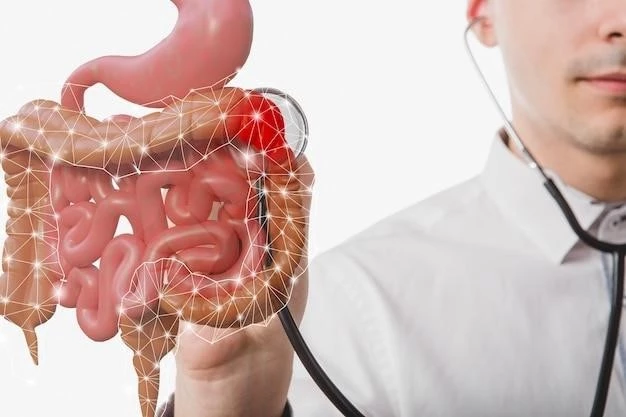Disease ⎯ Gastroenteritis‚ Eosinophilic
Introduction to Eosinophilic Gastroenteritis
Eosinophilic Gastroenteritis is a rare gastrointestinal condition characterized by the infiltration of eosinophils‚ a type of white blood cell‚ into the stomach‚ small intestine‚ or colon. This condition can lead to inflammation and tissue damage in the gastrointestinal tract.
Although the exact cause of Eosinophilic Gastroenteritis is not fully understood‚ it is believed to involve a combination of autoimmune‚ allergic‚ or infection-related factors triggering an abnormal immune response in the gastrointestinal system.
Patients with Eosinophilic Gastroenteritis may experience a range of symptoms‚ including abdominal pain‚ nausea‚ vomiting‚ diarrhea‚ weight loss‚ and malnutrition. The severity of symptoms can vary depending on the extent of eosinophilic infiltration and inflammation in the affected areas of the gastrointestinal tract.
Understanding the Pathophysiology
The pathophysiology of Eosinophilic Gastroenteritis involves a complex interplay of immune responses in the gastrointestinal tract. Eosinophils‚ a type of white blood cell‚ play a central role in the pathogenesis of this condition. Normally involved in immune responses to parasites and allergies‚ eosinophils can infiltrate the gastrointestinal mucosa in excessive numbers in Eosinophilic Gastroenteritis.

Upon activation‚ eosinophils release various inflammatory mediators that can damage the epithelial cells lining the stomach‚ small intestine‚ or colon‚ leading to tissue inflammation and dysfunction. This immune-mediated process contributes to the characteristic symptoms and complications seen in patients with Eosinophilic Gastroenteritis.
Research suggests that genetic predisposition‚ environmental factors‚ and dysregulated immune responses may contribute to the pathophysiology of Eosinophilic Gastroenteritis. Understanding the underlying mechanisms driving eosinophilic infiltration and inflammation in the gastrointestinal tract is critical for the development of targeted therapies and management strategies for this condition.
Symptoms and Clinical Presentation
Patients with Eosinophilic Gastroenteritis may present with a variety of symptoms‚ including abdominal pain‚ bloating‚ diarrhea‚ nausea‚ vomiting‚ and weight loss. The clinical presentation can vary depending on the location and extent of eosinophilic infiltration in the gastrointestinal tract.
In cases where the stomach is primarily affected‚ individuals may experience upper abdominal pain‚ early satiety‚ and vomiting. When the small intestine is involved‚ symptoms such as diarrhea‚ malabsorption‚ and nutrient deficiencies may manifest. Eosinophilic infiltration of the colon can lead to symptoms resembling inflammatory bowel disease‚ including bloody diarrhea and crampy abdominal pain.
Some patients with Eosinophilic Gastroenteritis may also develop extra-intestinal manifestations‚ such as skin rashes‚ joint pain‚ and respiratory symptoms. Due to the nonspecific nature of the symptoms‚ diagnosis of Eosinophilic Gastroenteritis often requires a high index of suspicion and thorough evaluation by healthcare professionals.
Diagnosis and Differential Diagnosis
Diagnosing Eosinophilic Gastroenteritis involves a combination of clinical evaluation‚ imaging studies‚ endoscopic procedures‚ and histological analysis of tissue samples obtained from the gastrointestinal tract. Blood tests may reveal elevated eosinophil levels‚ indicating a potential inflammatory process.
During an endoscopy‚ healthcare providers can visualize the affected areas and obtain biopsies for microscopic examination. Characteristic findings include eosinophilic infiltration of the mucosa. Imaging studies‚ such as CT scans or MRI‚ may also aid in assessing the extent of gastrointestinal involvement.
The differential diagnosis of Eosinophilic Gastroenteritis includes other gastrointestinal conditions that present with similar symptoms‚ such as inflammatory bowel disease‚ celiac disease‚ and gastritis. It is essential to differentiate Eosinophilic Gastroenteritis from these conditions to ensure appropriate treatment and management strategies.
Treatment and Management Approaches
The treatment of Eosinophilic Gastroenteritis aims to reduce inflammation‚ alleviate symptoms‚ and prevent complications. Management approaches may include dietary modifications‚ pharmacotherapy‚ and in some cases‚ minimally invasive procedures.
Dietary interventions often involve eliminating potential food triggers‚ such as common allergens‚ to reduce eosinophilic response. Pharmacological treatment may include corticosteroids to suppress inflammation‚ antihistamines to control allergic responses‚ and proton pump inhibitors to manage acid-related symptoms.
In cases where medications are ineffective or poorly tolerated‚ biologic therapies targeting specific immune pathways may be considered. Endoscopic procedures‚ such as dilation of strictures or removal of obstructing masses‚ can be performed for symptomatic relief and improvement of gastrointestinal function.
Long-term management of Eosinophilic Gastroenteritis may require regular monitoring‚ medication adjustments‚ and close follow-up with a multidisciplinary healthcare team‚ including gastroenterologists‚ allergists‚ and dietitians. Individualized treatment plans based on the patient’s clinical presentation and response to therapy are essential for optimizing outcomes and quality of life.
Research and Advancements in Eosinophilic Gastroenteritis
Ongoing medical research is focused on further understanding the underlying mechanisms of Eosinophilic Gastroenteritis‚ exploring novel diagnostic tools‚ and developing targeted therapies to improve patient outcomes. Recent advancements have shed light on the role of genetic factors‚ environmental triggers‚ and dysregulated immune responses in the pathogenesis of this condition.
Studies investigating biomarkers for early detection and monitoring of disease activity are underway‚ with the aim of enhancing diagnostic accuracy and treatment efficacy. Furthermore‚ the development of biologic agents that specifically target eosinophilic inflammation pathways represents a promising area of research for the management of Eosinophilic Gastroenteritis.
Clinical trials evaluating the safety and efficacy of emerging treatments‚ such as monoclonal antibodies and immune modulators‚ are contributing to the expansion of therapeutic options for patients with Eosinophilic Gastroenteritis. Collaborative efforts between clinicians‚ researchers‚ and pharmaceutical companies are essential for driving progress in the field and improving the care of individuals affected by this rare gastrointestinal condition.
Conclusion and Future Outlook
In conclusion‚ Eosinophilic Gastroenteritis is a complex gastrointestinal disorder characterized by eosinophilic infiltration and inflammation in the digestive tract. The understanding of the pathophysiology‚ clinical presentation‚ diagnosis‚ and treatment approaches for this condition has significantly evolved over the years.
Advancements in medical research continue to deepen our knowledge of Eosinophilic Gastroenteritis‚ leading to improved diagnostic techniques and innovative therapeutic options. The collaboration between healthcare professionals‚ scientists‚ and patients is crucial for advancing research initiatives and enhancing the care of individuals affected by this rare disease.
Looking ahead‚ the future outlook for Eosinophilic Gastroenteritis is promising‚ with ongoing studies exploring new treatment modalities‚ personalized medicine approaches‚ and potential biomarkers for disease monitoring. Continued efforts in research and clinical practice are essential for optimizing outcomes‚ increasing awareness‚ and ultimately improving the quality of life for individuals living with Eosinophilic Gastroenteritis.
